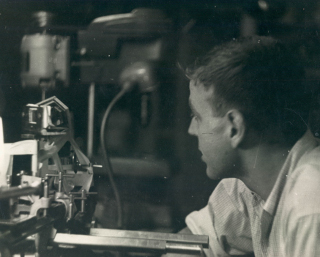Martin Harwit, Graduate Student: Martin Harwit, as a graduate student in physics at MIT, works on a corner-cube-reflector Michelson interferometer at Block Associates, a small optical firm formed and, at the time, fully-owned by physicist Myron C. Block.
Credit: AIP Emilio Segre Visual Archives, Harwit Collection
MIT required PhD students to declare a secondary field of study --- a “minor” --- and attend three courses in the minor field. At Oberlin and Michigan, I had taken a lot of chemistry courses, so I went to see the professor in charge and said, “I’ve taken a lot of chemistry courses already, and I’d like to get through this PhD pretty quickly because I just spent two years in the Army. Could you excuse the chemistry requirement, take my previous grades in chemistry from these other places and let me get by without doing this?” He replied, “No, no, it would be good for you to take more courses.” Then I thought, “The heck with that! If I’m going to take three courses I might as well take something I would enjoy.” So I signed up for courses in astronomy.
For my PhD thesis, I wanted to study an effect that required highly sensitivity infrared equipment. I had worked with infrared techniques at Michigan, and had the confidence --- totally unjustified I now think --- that I could build an instrument to detect this particular effect. It turned out to be far more difficult than I had expected; but by the time I finally succeeded, three years later, I did know how to make sensitive infrared measurements.
In the spring of 1960, I finished the thesis work, obtained the PhD degree, and went to work for a year on theoretical problems in astrophysics with Fred Hoyle at Cambridge University in England.


